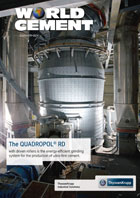Editorial comment
It is the time of year when www.worldcement.com fills up with financial results. Putting aside the issue of currency depreciation, which is making its presence felt in a number of companies’ bottom lines, energy supply is probably the second most prevalent issue impacting results, particularly for companies operating in Africa and parts of Asia.
Register for free »
Get started now for absolutely FREE, no credit card required.
For those of us living in countries with a reliable national grid, the idea of not having access to the power we need is like something out of a dystopian novel. In reality, more than a billion people worldwide don’t have access to electricity, and the very definition of ‘access to electricity’ is flimsy at best – certainly the minimal amount suggested per person would do little to help power a cement plant.
It is interesting to see the difference energy makes in different markets. For the US, the shale gas revolution has led some cement plants to consider converting to gas – though it has also brought down coal prices. It has also boosted the US economy, aided its recovery, leading to greater investment in infrastructure and construction and bringing all round good news for the cement industry. In contrast, in Nigeria, a country that flares some US$2 billion worth of gas annually, cement plants are turning to coal imports from South Africa to support production because the unreliable nature of the gas supply network frequently disrupts production.
In Dangote Cement’s 1H14 results, the company reported that fuel supply has been a problem, as a result of which the company is investing in coal-fired power. Ashaka Cement, a fellow Nigerian company, reported lower costs thanks to the increased use of coal. The Cement Company of Northern Nigeria is also planning to invest in its own power plant, though the fuel of choice was unspecified in initial reports. Nigeria has its own coal resources, but these are not currently being fully exploited. (Perhaps that’s another avenue for Aliko Dangote to explore.)
Over in India, the supply and price of coal is an ongoing issue. Imports are set to increase, particularly from Indonesia and Australia, as domestic coal resources are tied up in post-election scrutiny. In Indonesia, rising energy tariffs are leading cement producers to invest in their own power. Similar stories are occurring all over the world.
What is the long-term solution? Perhaps those companies operating in sunnier climes could follow the likes of Hanson Cement and CalPortland and start up a solar power plant to help power their operations? Cemex and Italgen are among those companies exploring the potential of wind power. Waste heat recovery is an increasingly popular option and as for fuel for the kiln, alternative fuels are taking off in emerging markets, having proven themselves in a big way in Europe. As energy security and climate change continue to make headlines, the cement industry must prove it is willing to adapt to survive.


